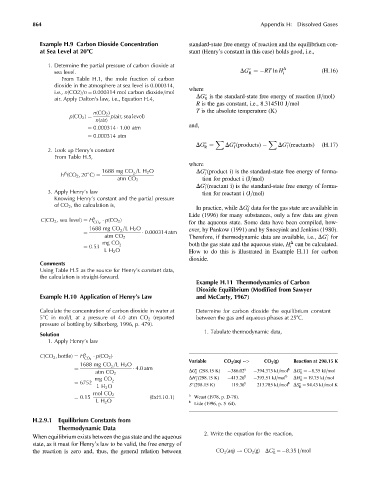Page 909 - Fundamentals of Water Treatment Unit Processes : Physical, Chemical, and Biological
P. 909
864 Appendix H: Dissolved Gases
Example H.9 Carbon Dioxide Concentration standard-state free energy of reaction and the equilibrium con-
at Sea Level at 208C stant (Henry’s constant in this case) holds good, i.e.,
1. Determine the partial pressure of carbon dioxide at D
sea level. DG ¼ RT ln H i (H:16)
R
From Table H.1, the mole fraction of carbon
dioxide in the atmosphere at sea level is 0.000314,
where
i.e., n(CO2)=n ¼ 0.000314 mol carbon dioxide=mol
DG is the standard-state free energy of reaction (J=mol)
air. Apply Dalton’s law, i.e., Equation H.4, R
R is the gas constant, i.e., 8.314510 J=mol
n(CO 2 ) T is the absolute temperature (K)
p(air, sea level)
n(air)
p(CO 2 ) ¼
and,
¼ 0:000314 1:00 atm
¼ 0:000314 atm
X X
DG (reactants) (H:17)
R
f
DG ¼ DG (products) f
2. Look up Henry’s constant
From Table H.5,
where
1688 mg CO =LH 2 O DG (product i) is the standard-state free energy of forma-
S 2 f
H (CO 2 ,20 C) ¼
atm CO 2 tion for product i (J=mol)
DG (reactant i) is the standard-state free energy of forma-
f
3. Apply Henry’s law tion for reactant i (J=mol)
Knowing Henry’s constant and the partial pressure
of CO 2 , the calculation is,
In practice, while DG data for the gas state are available in
f
Lide (1996) for many substances, only a few data are given
C(CO 2 , sea level) ¼ H S p(CO 2 )
CO 2 for the aqueous state. Some data have been compiled, how-
1688 mg CO =LH 2 O
2 ever, by Pankow (1991) and by Snoeyink and Jenkins (1980).
¼ 0:000314 atm
atm CO 2 Therefore, if thermodynamic data are available, i.e., DG for
f
mg CO both the gas state and the aqueous state, H can be calculated.
D
¼ 0:53 2 i
LH 2 O How to do this is illustrated in Example H.11 for carbon
dioxide.
Comments
Using Table H.5 as the source for Henry’s constant data,
the calculation is straight-forward.
Example H.11 Thermodynamics of Carbon
Dioxide Equilibrium (Modified from Sawyer
Example H.10 Application of Henry’s Law and McCarty, 1967)
Calculate the concentration of carbon dioxide in water at Determine for carbon dioxide the equilibrium constant
58C in mol=L at a pressure of 4.0 atm CO 2 (reported between the gas and aqueous phases at 258C.
pressure of bottling by Silberberg, 1996, p. 479).
1. Tabulate thermodynamic data,
Solution
1. Apply Henry’s law
C(CO 2 , bottle) ¼ H S p(CO 2 )
CO 2
Variable CO 2 (aq) --> CO 2 (g) Reaction at 298.15 K
1688 mg CO =LH 2 O
2
¼ 4:0 atm DG (298.15 K) 386.02 a 394.373 kJ=mol b DG ¼ 8.35 kJ=mol
atm CO 2 f R
mg CO DH (298:15 K) 413.26 b 393.51 kJ=mol b DH ¼ 19.75 kJ=mol
R
f
¼ 6752 2 b b
LH 2 O S (298:15 K) 119.36 213.785 kJ=mol DS ¼ 94.43 kJ=mol K
R
mol CO 2 a
¼ 0:15 (ExH:10:1) Weast (1978, p. D-78).
LH 2 O b
Lide (1996, p. 5–64).
H.2.9.1 Equilibrium Constants from
Thermodynamic Data
2. Write the equation for the reaction,
When equilibrium exists between the gas state and the aqueous
state, as it must for Henry’s law to be valid, the free energy of
the reaction is zero and, thus, the general relation between CO 2 (aq) ! CO 2 (g) DG ¼ 8.35 J=mol
R

